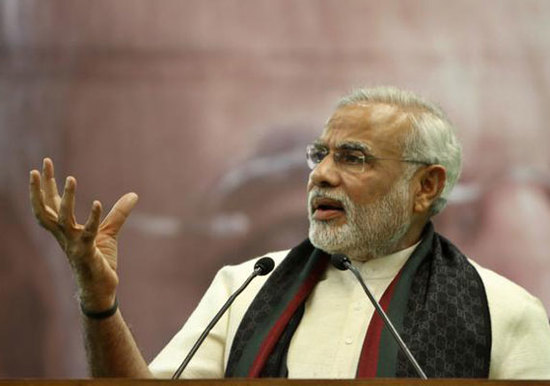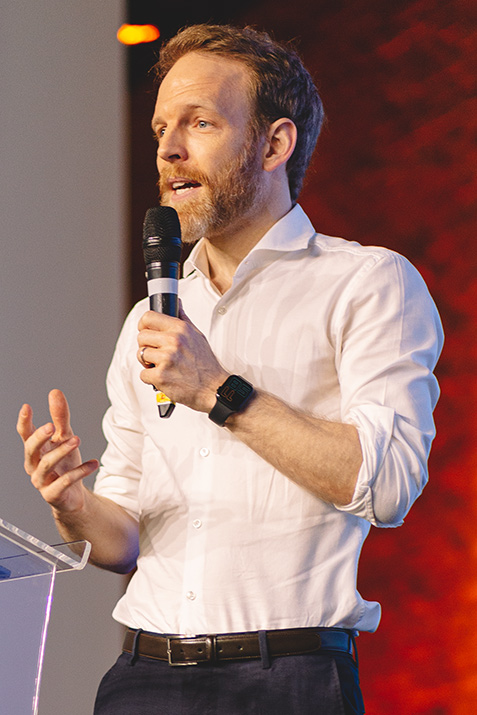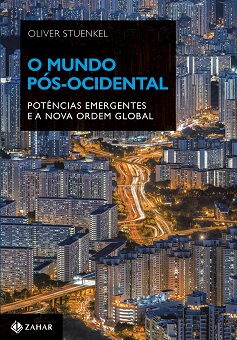Contrary to other emerging powers such as Brazil, foreign policy is a key element of the public debate in India. The country is involved in major territorial disputes with two nuclear powers. It fought three wars with Pakistan and one with China, which have fundamentally shaped the way India thinks about its place in the world. As a consequence, India is the world’s no.1 arms importer, purchasing $12.7 billion in arms during 2007-2011.
In May, more than 750 million Indians will choose their next Prime Minister, 150 million of which will be first-time voters. After a lacklustre second term, Indians are likely to punish the Congress Party, which has been in power for most of the time since independence in 1947. While India’s electoral politics are far too complex to make any certain predictions, there is a good chance that Narendra Modi (pictured above), Chief Minister of Gujarat, an economically vibrant state in India’s North-West, will get the job.
What would his foreign policy look like?
Rahul Sagar writes that there are four competing visions of India’s place in the international system.
The moralists have the view that India should serve as a moral example in world politics, an idea that can be traced to the revolutionary character of India’s freedom movement. It has strong pacifist and Gandhian elements, and its supporters tried to turn India, after independence, into the first large power without an army – they rejected the notion that peace could only be sought through strength.
The Hindu nationalists, fiercely critical of the moralists, are driven by impulses of pride and shame: pride in what they consider the self-evident importance of Indian civilization, and shame at its past subjugation by Muslim and British invaders, and at its weak response to security threats. “From this potent mix of motives comes a burning desire to resurrect the glory of India and to prevent the recurrence of humiliation.” Sagar writes. This line of thought is most visible amongst the radicals of Modi’s BJP.
The third group is what Sagar calls the strategists. They are also critical of the moralists, and recognize force as the ultimate arbiter of international politics. That leads them to promote India’s economic and military capabilities, especially a credible second-
strike nuclear capability and a comprehensive array of conventional military force. Yet contrary to the Hindu nationalists, they favor rapid modernization. The Hindu nationalists, on the other hand, are suspicious of modernity. According to the strategists, India needs to practice what has been described as statecraft “characterized by unsentimental, quick-thinking and fleet-footed foreign and military policies able to exploit opportunities and to register tangible, not abstract, gains for the country”.
The final and most recent criticism of the moralists are the liberal internationalists, who believe that India’s third-worldish attitude brought the country few benefits. India, according to them, can only grow through trade and liberalism. The view on India’s place in the world is informed by the notion that power, rather than moral prestige, ought to be the objective of state action, since it is the ‘argument of power’, rather than the ‘power of the argument’, that is decisive in international politics.
While very few Indian decision-makers are informed by one school alone, they provide a useful framework to think about how Narendra Modi – or any other candidate – would design India’s foreign policy strategy if elected Prime Minister.
Modi leads the BJP, so he is likely to be influenced by ideas from the Hindu nationalist camp – yet at the same time, he may also seek to distance himself from the radical wing of the BJP to attract Muslim voters.
What seems most obvious is that Modi is no moralist. The way Modi expressed his admiration for Prime Minister Vajpayee’s balance – between “shakti and shanti” (power and peace, in Sanskrit) – is a clear appeal to the Hindu heritage that is central to the core ideology of his party (even though it can pretty much mean anything). Yet even he would have to operate within a foreign policy tradition that is deeply influenced by Gandhian ideas.
Still, he has signaled that he’d favor a more “muscular” and aggressive foreign policy compared to what he described as India’s current “weak” strategy. He speaks of a rapid naval build-up and a firmer response to border violations. At the same time, if elected, he is unlikely to change several pillars of India’s international strategy, such as its “Look East” policy.
“The Chinese will understand the new PM is not a wimp and they won’t do anything adventurous,” a BJP strategist says. Modi has argued that India “cannot allow China to dominate India in foreign policy matters.” Yet that does not solve India’s dilemma: Beijing poses the greatest threat to India’s rise, but it also needs to strengthen its economic relation with China to return to satisfactory growth figures.
Ties with the United States and Europe may suffer somewhat, as Western leaders would likely be reluctant to be seen with a man who is internationally known for his controversial role in the 2002 riots in Gujarat, which led to the death of nearly 1000 Muslims. While an investigation commissioned by India’s Supreme Court cleared him of wrongdoing during the episode, he has refused to publicly apologize or denounce the violence. Yet the underlying rationale for using a solid partnership with the US as a means to balance China remains.
In the Middle East, Modi may continue his party’s tradition of strengthening his ties to Israel — a move which led critics to believe that this was not just a security partnership but also a relationship with some religious and ideological elements.
Interestingly enough, Modi’s first big international trip would likely be to Brazil to attend the 6th BRICS Summit – a meeting that would give him the opportunity to directly engage with Vladimir Putin and Xi Jinping, and to begin articulating his foreign policy vision.
Perhaps most importantly, several observers have noted the centrality of economics in his thinking about foreign policy. This may make liberal internationalist ideas seem attractive to Modi, and he may support reducing trade barriers and strengthen India’s integration in the world economy. Despite his controversial human rights record, Modi has the capacity to become the darling of the international business community. This would also move India closer to the United States.
The biggest question, of course, is whether Modi would seek a “grand bargain” and settle parts of the long-standing conflict with Pakistan. While impossible to predict, it would certainly assure him a place in history as one of India’s greatest foreign policy makers.
Read also:
2014: Crunch time in the Global South
Book review: “Samudra Mathan: Sino-Indian Rivalry in the Indo-Pacific” by C. Raja Mohan
Lula’s Indian dream, ten years on
Photo credit: Hindustan Times









